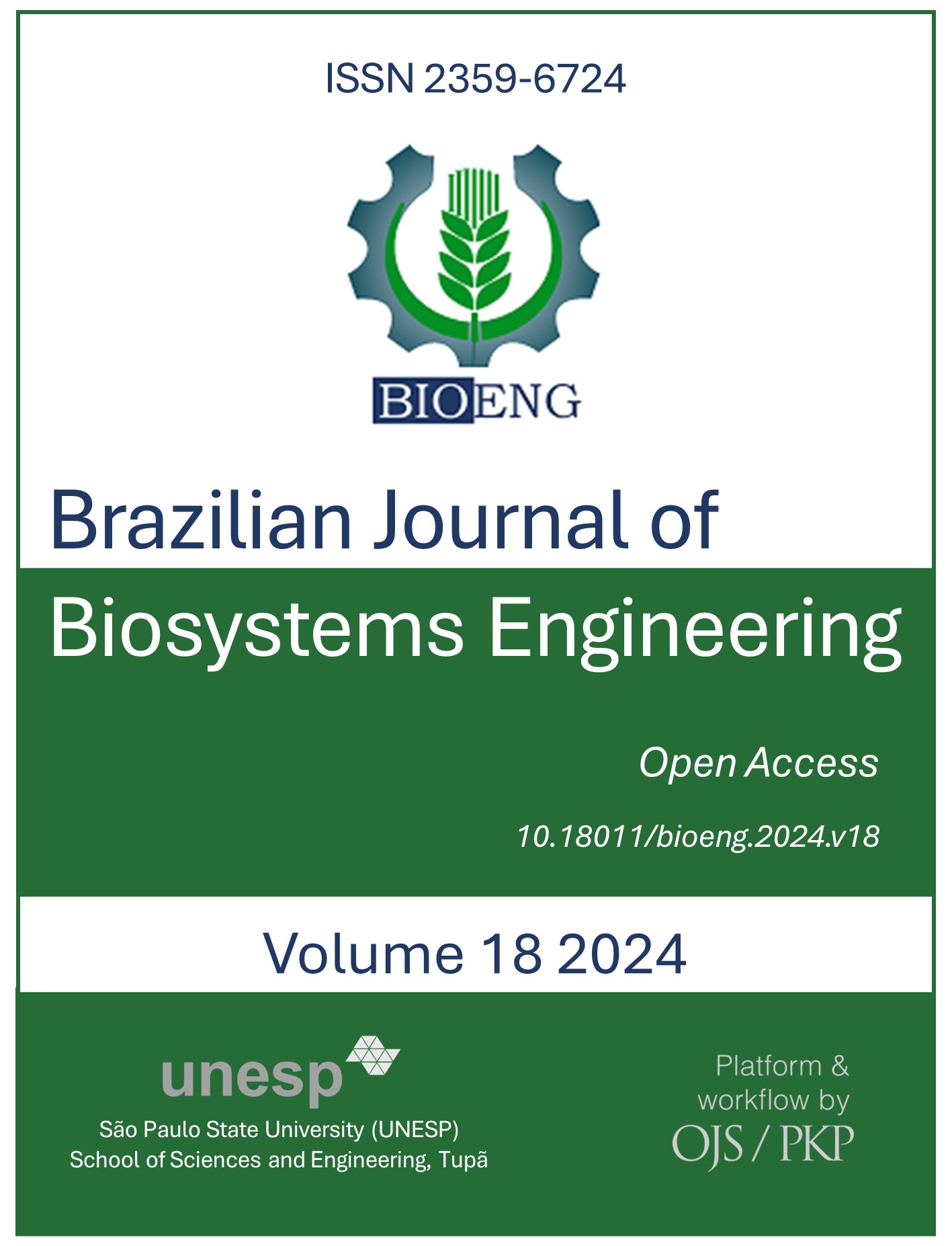Soil compaction in progressive agricultural tractor treads
DOI:
https://doi.org/10.18011/bioeng.2024.v18.1117Keywords:
Mechanization, Soil density, Cone indexAbstract
Soil compaction is one of the main problems in world agriculture. It is known that, even in soil conservation management, such as in no-till, the transit of agricultural machinery damages the soil structure, therefore, it is essential to better understand the compaction processes and ways to alleviate the problem. In soils that have traditional tillage management, just one machine pass can damage the physical structure. This research aimed to evaluate the levels of compaction as a function of different passages of an agricultural tractor, considering the hypothesis that, during agricultural operations, a machine transits several times through the same place in the crop. The experiment was carried out on plowed and harrowed agricultural soil in the state of São Paulo. Resistance to soil penetration at different depths was evaluated, and the averages were correlated as a function of the number of steps taken by the tractor. Results showed that approximately 60% of the total soil compaction occurs in the first passes of the agricultural tractor, and above five passes the increase in compaction is minimal. At depths of 20 to 30 cm, the largest RSPs were found. It is concluded that a good planning of machinery traffic is essential, because in the case of a motor-mechanized set moving out of its predestined route, the soil structure is permanently affected.
Downloads
References
Alaoui, A., & Diserens, E. (2018). Mapping soil compaction–A review. Current opinion in environmental science & health, 5, 60-66. https://doi.org/10.1016/j.coesh.2018.05.003 DOI: https://doi.org/10.1016/j.coesh.2018.05.003
Arcoverde, S. N., Souza, C., Rafull, L. Z., Cortez, J. W., & Orlando, R. C. (2020). Soybean agronomic performance and soil physical attributes under tractor traffic intensities. Engenharia Agrícola, 40, 113-120. https://doi.org/10.1590/1809-4430-Eng.Agric.v40n1p113-120/2020. DOI: https://doi.org/10.1590/1809-4430-eng.agric.v40n1p113-120/2020
Bergamin, A. C., Vitorino, A. C. T., Franchini, J. C., Souza, C. M. A. D., & Souza, F. R. D. (2010). Compactação em um Latossolo Vermelho distroférrico e suas relações com o crescimento radicular do milho. Revista Brasileira de Ciência do Solo, 34(3), 681-691. https://doi.org/10.1590/S0100-06832010000300009 DOI: https://doi.org/10.1590/S0100-06832010000300009
Camargo, O. A., Alleoni, L. R. F. (2019) Causas da compactação do solo. Disponível em: <http://www.infobibos.com/Artigos/CompSolo/C3/Comp3.htm>. Access: 01 out. 2021.
Colombi, T., & Keller, T. (2019). Developing strategies to recover crop productivity after soil compaction—A plant eco-physiological perspective. Soil and Tillage Research, 191, 156-161. https://doi.org/10.1016/j.still.2019.04.008 DOI: https://doi.org/10.1016/j.still.2019.04.008
Esteban, D. A. A., de Souza, Z. M., Tormena, C. A., Lovera, L. H., de Souza Lima, E., de Oliveira, I. N., & de Paula Ribeiro, N. (2019). Soil compaction, root system and productivity of sugarcane under different row spacing and controlled traffic at harvest. Soil and Tillage Research, 187, 60-71. https://doi.org/10.1016/j.still.2018.11.015 DOI: https://doi.org/10.1016/j.still.2018.11.015
Hargreaves, P. R., Baker, K. L., Graceson, A., Bonnett, S., Ball, B. C., & Cloy, J. M. (2019). Soil compaction effects on grassland silage yields and soil structure under different levels of compaction over three years. European Journal of Agronomy, 109, 125916. https://doi.org/10.1016/j.eja.2019.125916 DOI: https://doi.org/10.1016/j.eja.2019.125916
Horn, R. (2015). Soil compaction and consequences of soil deformation on changes in soil functions. Task force: Soil matters—Solutions under foot, 28-33.
Martins, P. C. C., Dias Junior, M. D. S., Ajayi, A. E., Takahashi, E. N., & Tassinari, D. (2018). Soil compaction during harvest operations in five tropical soils with different textures under eucalyptus forests. Ciência e Agrotecnologia, 42, 58-68. http://dx.doi.org/10.1590/1413-70542018421005217 DOI: https://doi.org/10.1590/1413-70542018421005217
Molina Junior, W. F. (2017). Comportamento mecânico do solo em operações agrícolas. Piracicaba: ESALQ/USP. https://doi.org/10.11606/9788592238407 DOI: https://doi.org/10.11606/9788592238407
de Moraes, M. T., Debiasi, H., Franchini, J. C., Mastroberti, A. A., Levien, R., Leitner, D., & Schnepf, A. (2020). Soil compaction impacts soybean root growth in an Oxisol from subtropical Brazil. Soil and Tillage Research, 200, 104611. https://doi.org/10.1016/j.still.2020.104611 DOI: https://doi.org/10.1016/j.still.2020.104611
Olubanjo, O. O., & Yessoufou, M. A. (2019). Effect of Soil Compaction on the Growth and Nutrient Uptake of Zea Mays L. Sustainable Agriculture Research, 8(526-2020-528), 46-54. https://doi.org/sar.v8n2p46 DOI: https://doi.org/10.5539/sar.v8n2p46
Santos, H. G., JACOMINE, P. K. T., Dos Anjos, L. H. C., De Oliveira, V. A., LUMBRERAS, J. F., COELHO, M. R., ... & CUNHA, T. J. F. (2018). Sistema brasileiro de classificação de solos. Brasília, DF: Embrapa, 2018.
Ungureanu, N., Vlăduţ, V., & Cujbescu, D. (2019). Soil compaction under the wheel of a sprayer. In E3S web of conferences (Vol. 112, p. 03027). EDP Sciences. https://doi.org/10.1051/e3sconf/201911203027 DOI: https://doi.org/10.1051/e3sconf/201911203027
Valicheski, R. R., Grossklaus, F., Stürmer, S. L., Tramontin, A. L., & Baade, E. S. (2012). Desenvolvimento de plantas de cobertura e produtividade da soja conforme atributos físicos em solo compactado. Revista Brasileira de Engenharia Agrícola e Ambiental, 16(9), 969-977. https://doi.org/10.1590/S1415-43662012000900007 DOI: https://doi.org/10.1590/S1415-43662012000900007
Downloads
Published
How to Cite
Issue
Section
License
Copyright (c) 2024 The Authors

This work is licensed under a Creative Commons Attribution 4.0 International License.
By publishing in this journal, authors agree to the following terms:
a) Authors retain copyright and grant the journal the right of first publication. The work is simultaneously licensed under the Creative Commons Attribution License, which permits sharing and adaptation of the work with appropriate credit to the authors and the journal.
b) Authors may enter into separate, additional agreements for non-exclusive distribution of the published version of the work (e.g., posting to an institutional repository or inclusion in a book), provided that proper credit is given to the original publication in this journal.










